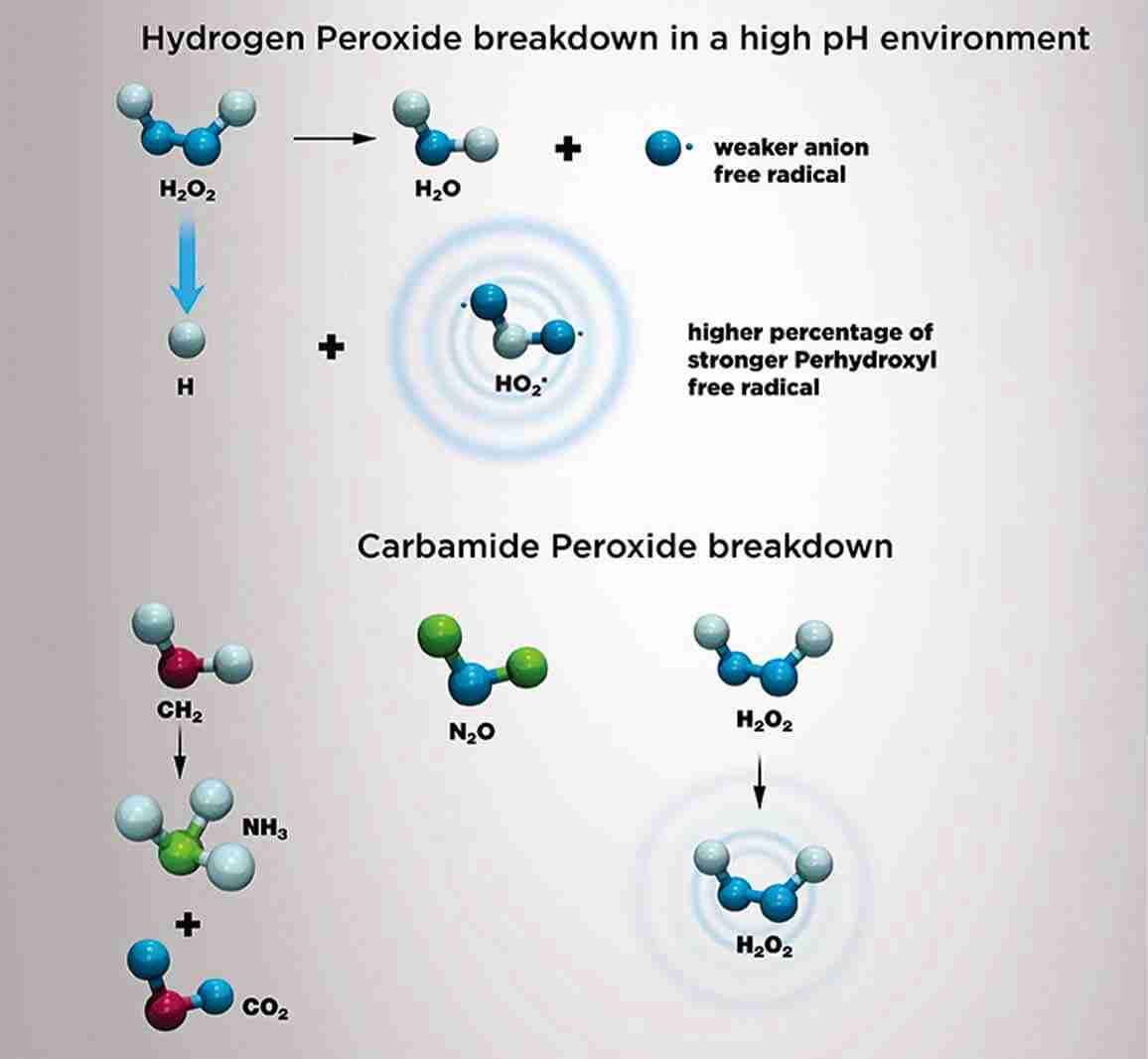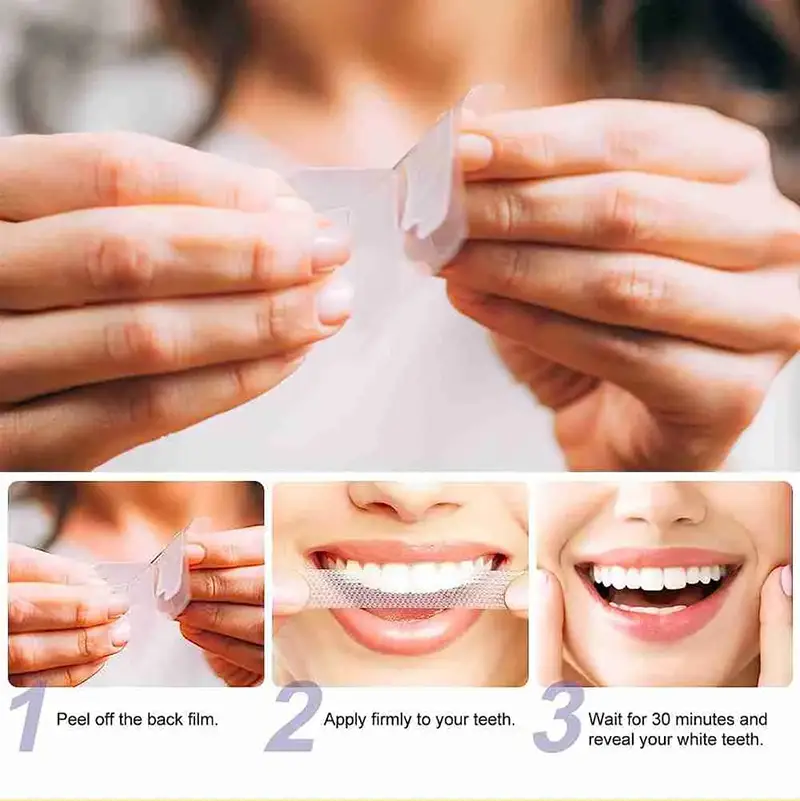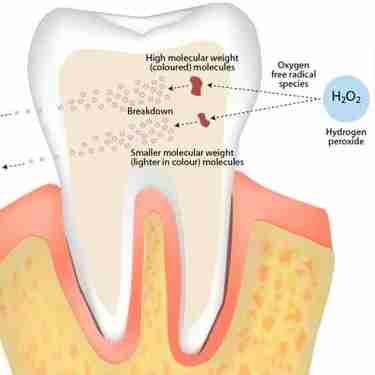HP/CP/PAP whitening science
The science behind HP/CP/PAP whitening is based on the use of hydrogen peroxide to break down stains on teeth.
Formulating is an ongoing process.
Our study aimed to develop a new dental whitening formulation that is as effective as carbamide peroxide but at significantly lower hydrogen peroxide concentrations.
Our expert formulators can assist you in developing high-quality oral whitening agents. Our scientists conduct feasibility studies to identify critical variables, eliminate inefficiencies, and optimize process development. You will work with a team that has the experience and equipment to quickly take your product from R&D to commercialization.

Efficacy is not easy to achieve.
10+
Years of Study
250+
Formulation Developed
20+
Lab Machines
350+
Challenges Overcome Yearly
Safe And Effective Ingredients In Our Products
Hydrogen Peroxide(HP)
Hydrogen peroxide diffuses through the inter-prismatic spaces on the enamel into the tooth, where it interacts with organic chromophores to cause tooth discoloration. The reaction process is affected by temperature, pH, and light. Hydrogen peroxide is preferred for tooth whitening because it breaks down faster and produces results more quickly.
• Molecular formula: H2O2
• Molecular weight: 34.01
• Melting point: -33°C
• Boiling point: 108°C
• Density: 1.13 g/ml at 20°C
• Storage conditions: 2~8°C
• p-value: 2~4(H2O2, 20°C)
Carbamide Peroxide(CP)
Carbamide peroxide is another common ingredient in teeth whitening gels. It is composed of urea and hydrogen peroxide. When carbamide peroxide comes into contact with water, it breaks down into hydrogen peroxide and urea. The hydrogen peroxide then acts on the stained teeth to produce a bleaching effect, as explained above.
• Molecular formula: CO(NH2)•H2O2
• Molecular weight: 92.0541
• Melting point: 90~93°C
• Boiling point: 196.6°C at 760 mmHg
• Storage conditions: 2~89°C
Phthalimidoperoxycaproic Acid(PAP)
Phthalimidoperoxycaproic acid (PAP) is a synthetic organic peroxy acid that is primarily used as a bleaching activator and teeth whitening agent. PAP works by whitening the discolored molecules in teeth, making them appear whiter. PAP is a safe and effective teeth whitening agent that is backed by scientific research.
Phthalimidoperoxycaproicacid + Secondary Ingredients (PAP+)
Phthalimidoperoxycaproic Acid + Secondary Ingredients (PAP+) is a safe and effective teeth whitening formula that uses hydrogen peroxide to break down stains on teeth. It is a non-abrasive and non-toxic formula that is gentle on teeth and gums. PAP+ is available in a variety of products, including toothpaste, mouthwash, and strips.
The PAP+ formula is a safe and effective teeth whitening solution that uses potassium citrate to help with any pre-existing sensitivity and hydroxyapatite (HAp) to remineralize teeth by replacing minerals and strengthening weakened enamel. HAp is a naturally occurring form of calcium apatite found in bones, saliva, and teeth.

What are the most common ingredients in teeth whitening products?
Teeth whitening products can contain a variety of ingredients, each with its own specific function and ability to whiten teeth on different levels. Some of the most common ingredients in teeth whitening products include hydrogen peroxide, carbamide peroxide, and baking soda. These ingredients work by breaking down stains and discoloration on the teeth, resulting in a whiter smile.
Alcohol
Alcohol can dehydrate the gel or brush-on formula, making it less effective at whitening teeth. Alcohol can also dry out the mouth, which can lead to bad breath and tooth decay.
Blue covarine
Blue covarine is a natural blue pigment that can be used to whiten teeth. It is often combined with silica-based whitening formulas to create a more effective and longer-lasting whitening effect. Blue covarine works by adhering to the surface of teeth and reflecting light more effectively, which makes teeth appear whiter.
Carbamide peroxide
Many store-bought gel-based bleaching products contain the active ingredient carbamide peroxide, which breaks down into hydrogen peroxide. Carbamide peroxide is a safe and effective way to whiten teeth, but it is important to use it as directed to avoid any potential side effects.
Carbopol
Carbopol polymers are used in teeth whitening gels to thicken, stabilize and prolong the effectiveness of the whitening formula. Carbopol is often combined with carbamide peroxide or hydrogen peroxide to create a powerful and safe whitening solution.
Chlorine dioxide
Chlorine dioxide is a bleaching agent that was once seen as an alternative to hydrogen peroxide. It works similarly to peroxide by dehydrating the enamel, making it more porous and allowing stains to be removed. However, chlorine dioxide-based whitening products are now banned in the UK due to concerns about the long-term damage caused by the increased porosity of the enamel. It is recommended to avoid products containing chlorine dioxide.
Citric acid
Citric acid oil, which is found in lemon and orange peels, is a common ingredient in whitening strips. It has been shown to whiten teeth by breaking down stains on the surface of the tooth.
Glycerin
Glycerin speeds up the teeth whitening process by drawing moisture out of the enamel, allowing the whitening agent to penetrate deeper and remove subsurface stains. This can cause sensitivity, but glycerin also helps to extend the shelf life of the product.
Hydrogen peroxide
Hydrogen peroxide is the most common whitening ingredient used in dental office whitening procedures. It is more concentrated than the 3% hydrogen peroxide that people typically buy for home use. This allows for faster and more effective whitening, but it is important to apply it properly to avoid soft tissue irritation. Using a gel-activating light can further accelerate results.
Purified water
Purified water is used to create the solution of whitening ingredients.
Silica
Silica dioxide is a common ingredient in toothpastes. It is a type of abrasive that helps to remove stains and plaque from teeth. Silica particles are small and hard, and they can easily remove plaque and stains from the surface of teeth. This helps to keep teeth clean and white.
Sodium chloride
Sodium chloride, the chemical name for table salt, is an effective whitening agent that can be used in non-peroxide whitening products.
Sodium hexametaphosphate and pyrophosphates
Pyrophosphate and tetrasodium pyrophosphate are two ingredients that are commonly used in teeth whitening products. They are known for their ability to break down extrinsic stains and prevent tartar buildup. They also have the added benefit of adhering to the pellicle, which is a thin layer of protein that coats the teeth. This helps to prevent further staining. Pyrophosphate also temporarily inhibits the formation of hydroxylapatite, the mineral that makes up tooth enamel. This allows the whitening agent to work more effectively.
Sodium hydroxide
Lye, also known as sodium hydroxide, is a common cleaning agent in soap and a whitening ingredient in whitening toothpastes. It is effective in dissolving protein-based deposits, which are the main component of the pellicle coating on the enamel.
Sodium saccharin
Sodium saccharin is an artificial sweetener that is 300 times sweeter than sugar. It is used in a variety of foods and beverages, including diet sodas, candy, and baked goods. Sodium saccharin is considered to be safe for human consumption by the FDA. However, some studies have linked saccharin to bladder cancer in rats. More research is needed to determine whether saccharin is a carcinogen for humans.
Sodium stannate
Sodium stannate is a colorless salt that is used as a stabilizing agent for hydrogen peroxide. A stabilizing agent is needed to keep the peroxide from degrading so the peroxide effect can last longer. Sodium stannate is a safe and effective stabilizing agent for hydrogen peroxide. It is commonly used in toothpaste and other oral care products.
Xylitol
Xylitol is a plant-based sweetener that does not affect blood sugar levels. It also has the ability to reduce tooth decay by helping to remineralize tooth enamel. Xylitol is a healthy alternative to sugar and can be used in a variety of foods and beverages.

Frequently Asked Questions (FAQs)
What ingredients do the best teeth whitening toothpastes contain?
Teeth whitening toothpastes that contain hydrogen peroxide and silica are popular choices for sensitive teeth and gums. The active ingredient in Arm & Hammer whitening toothpaste is peroxide, which is a mild abrasive that can help to remove surface stains on teeth. Other common whitening ingredients in toothpaste include carbamide peroxide and baking soda.
Can whitening damage teeth?
Teeth whitening is a safe and effective way to whiten your teeth. It involves the use of a bleaching agent to break down stains on the surface of your teeth. Teeth whitening can be done in a variety of ways, including at-home kits, in-office procedures, and laser treatments. The results of teeth whitening can last for several months, but it is important to note that teeth whitening cannot make your teeth whiter than their natural color.
The dentin is the main portion of the tooth that determines its color. A whitening solution is applied to the front surface of the tooth, and then travels through the tooth enamel to the dentin. The stained tissue in the inner layer will begin to lighten.
What ingredients do the best teeth whitening gel contain?
Peroxide is the active ingredient in nearly all tooth whitening products. There are two types – carbamide peroxide and hydrogen peroxide. Both work essentially the same way. Peroxide breaks down and allows oxygen into the enamel of teeth, which bleaches them. Carbamide Peroxide is hydrogen peroxide combined with urea (an aqueous solution). Tooth whitening products containing carbamide peroxide typically range from concentrations of 6% to 22%.
What ingredients do the best teeth whitening strips contain?
Teeth whitening strips are made from a thin, flexible plastic and coated with a low concentration of bleaching product. They are pre-packaged and placed on the teeth, conforming to their shape easily. Hydrogen peroxide, chlorine dioxide, and PEG compounds are some of the ingredients that ensure the effectiveness of teeth whitening strips.
Latest Trend: Hismile PAP+
Hismile, a leading brand in teeth whitening products, has launched a new teeth whitening kit with their proprietary formula called PAP+. This new kit is clinically proven to whiten teeth up to 10 shades in just 14 days. Congratulations to Hismile for their innovation and commitment to providing their customers with the best possible teeth whitening experience.
As a professional teeth whitening products manufacturer, we would like to share some information about PAP in order to help brands update their formulas to follow the trends set by Hismile and other leading brands.
Lidercare Manufacturing Team Announces New PAP+ Teeth Whitening Gel
Hismile, an international teeth whitening company, has recently launched a revolutionary new teeth whitening formula that does not use peroxide. The formula is clinically proven to be safe and effective, and it delivers results in just a few days. Hismile is the only teeth whitening company that offers a money-back guarantee, so you can try it risk-free.
